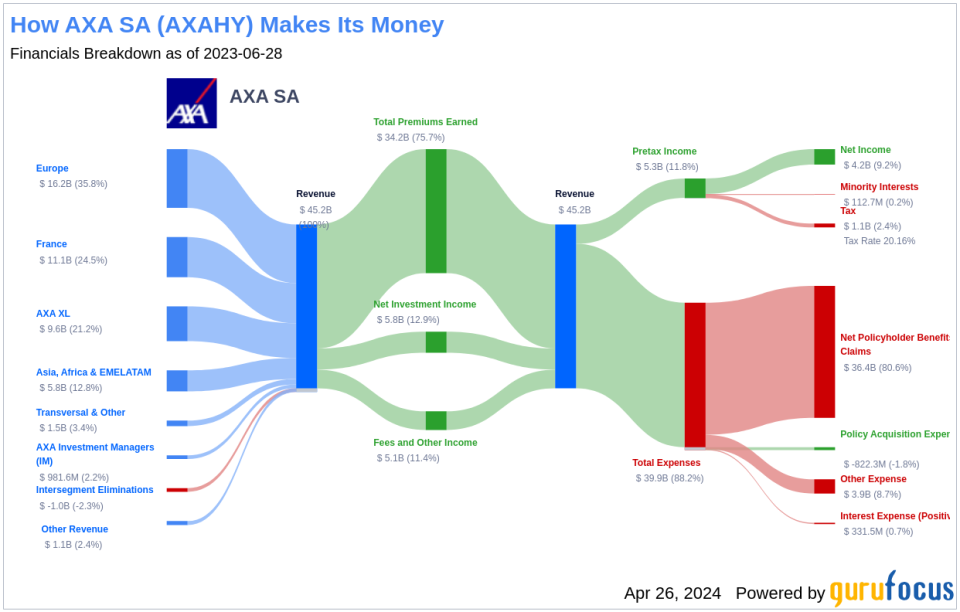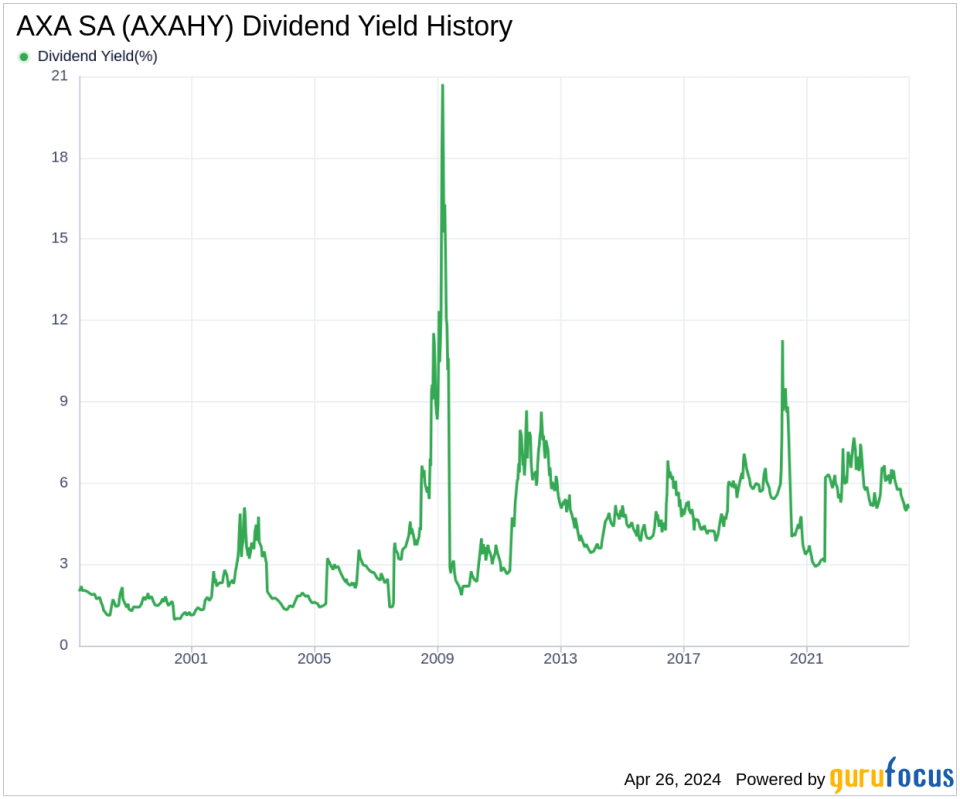AXA SA's Dividend Analysis
Understanding the Upcoming Dividend of AXA SA (AXAHY)
AXA SA(AXAHY) recently announced a dividend of $2.1 per share, payable on 2024-05-21, with the ex-dividend date set for 2024-04-26. As investors look forward to this upcoming payment, the spotlight also shines on the company's dividend history, yield, and growth rates. Using the data from GuruFocus, let's look into AXA SA's dividend performance and assess its sustainability.
What Does AXA SA Do?
This Powerful Chart Made Peter Lynch 29% A Year For 13 Years
How to calculate the intrinsic value of a stock?
AXA SA's origins date back to Ancienne Mutuelle, which was one of the few insurers that remained after the creation of the French security system. With the threat of nationalization, a merger took place between three insurance groups: The Drouot Group, AXA (still known as Mutuelles Unies in 1982), and Presence Group. Ten years later AXA acquired North American life insurer Equitable Holdings. This was a time of expansion as AXA also bought UAP, a large French insurer. Yet, as markets crashed at the turn of the millennium, AXA decided to refocus its business and exited its stake in U.S. investment bank Donaldson, Lufkin & Jenrette. A few years later the firm expanded again with the acquisition of Swiss insurer Winterthur. About 5 years ago AXA began reshaping its portfolio to technical risks.
A Glimpse at AXA SA's Dividend History
AXA SA has maintained a consistent dividend payment record since 1997. Dividends are currently distributed on a yearly basis. Below is a chart showing annual Dividends Per Share for tracking historical trends.
Breaking Down AXA SA's Dividend Yield and Growth
As of today, AXA SA currently has a 12-month trailing dividend yield of 5.16% and a 12-month forward dividend yield of 5.81%. This suggests an expectation of increased dividend payments over the next 12 months. Over the past three years, AXA SA's annual dividend growth rate was 4.70%. Extended to a five-year horizon, this rate decreased to 3.50% per year. And over the past decade, AXA SA's annual dividends per share growth rate stands at 6.80%.
Based on AXA SA's dividend yield and five-year growth rate, the 5-year yield on cost of AXA SA stock as of today is approximately 6.13%.
The Sustainability Question: Payout Ratio and Profitability
To assess the sustainability of the dividend, one needs to evaluate the company's payout ratio. The dividend payout ratio provides insights into the portion of earnings the company distributes as dividends. A lower ratio suggests that the company retains a significant part of its earnings, thereby ensuring the availability of funds for future growth and unexpected downturns. As of 2023-06-30, AXA SA's dividend payout ratio is 0.50.
AXA SA's profitability rank, offers an understanding of the company's earnings prowess relative to its peers. GuruFocus ranks AXA SA's profitability 5 out of 10 as of 2023-06-30, suggesting fair profitability. The company has reported positive net income for each of year over the past decade, further solidifying its high profitability.
Growth Metrics: The Future Outlook
To ensure the sustainability of dividends, a company must have robust growth metrics. AXA SA's growth rank of 5 out of 10 suggests that the company has a fair growth outlook. Revenue is the lifeblood of any company, and AXA SA's revenue per share, combined with the 3-year revenue growth rate, indicates a strong revenue model. AXA SA's revenue has increased by approximately -8.20% per year on average, a rate that underperforms than approximately 82.42% of global competitors.
The company's 3-year EPS growth rate showcases its capability to grow its earnings, a critical component for sustaining dividends in the long run. During the past three years, AXA SA's earnings increased by approximately 3.70% per year on average, a rate that underperforms than approximately 59.11% of global competitors.
Lastly, the company's 5-year EBITDA growth rate of 2.20%, which underperforms than approximately 61.41% of global competitors.
Next Steps
Considering AXA SA's consistent dividend payments, moderate dividend growth rate, manageable payout ratio, and fair profitability, the company's dividend appears sustainable in the short term. However, the less than stellar growth metrics, including revenue and earnings performance, may raise concerns about the long-term growth potential and the ability to maintain or increase dividends. Investors should keep an eye on these indicators for any signs of significant change that could affect future dividends. For those looking to expand their portfolio with income-generating stocks, GuruFocus Premium users can screen for high-dividend yield stocks using the High Dividend Yield Screener.
This article, generated by GuruFocus, is designed to provide general insights and is not tailored financial advice. Our commentary is rooted in historical data and analyst projections, utilizing an impartial methodology, and is not intended to serve as specific investment guidance. It does not formulate a recommendation to purchase or divest any stock and does not consider individual investment objectives or financial circumstances. Our objective is to deliver long-term, fundamental data-driven analysis. Be aware that our analysis might not incorporate the most recent, price-sensitive company announcements or qualitative information. GuruFocus holds no position in the stocks mentioned herein.
This article first appeared on GuruFocus.

 Yahoo Finance
Yahoo Finance 

